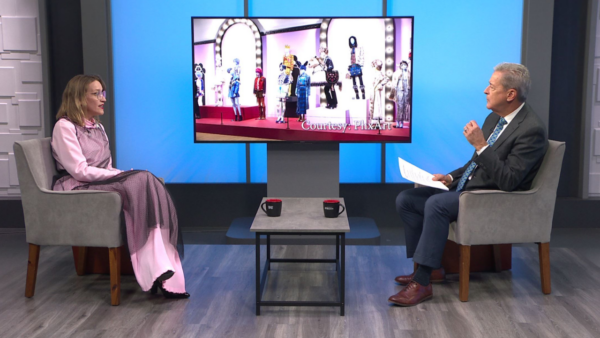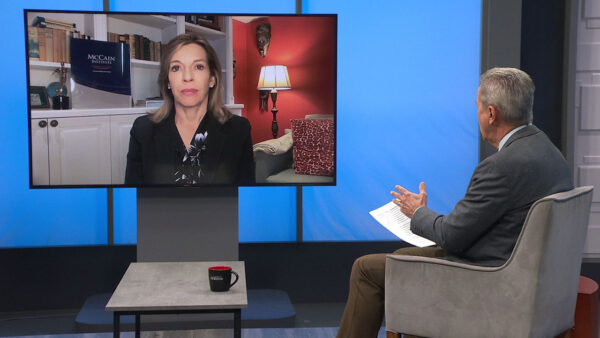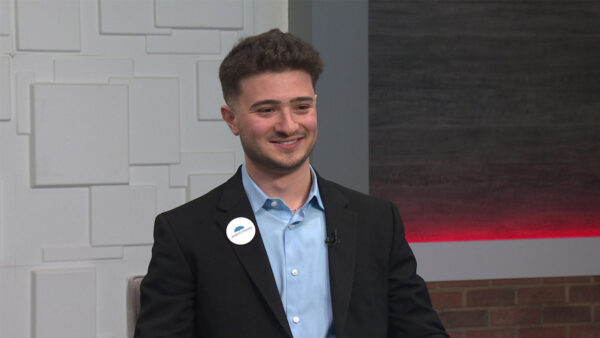Magic tricks take advantage of how the human brains pay attention to surroundings. Phoenix Barrow Neurological Institute researchers Stephen Macknik and Susana Martinez-Conde have traveled the world to study how magicians fool the brain and the science behind that. They will talk about their new book based on that research, “Sleights of Mind,” as Tony the Magician performs tricks they will analyze.
Ted Simons: Vision is one of our most trusted links to the outside world, but you can't always believe everything you see. Magic tricks, for example, take advantage our brain's vulnerability to illusions. Two researchers from Barrow Neurological Institute decided to travel the world and meet with magicians to study why the brain can be fooled by magic tricks. The result of their efforts is a book titled "Sleights of Mind." Here to talk about their findings are Stephen Macknik and Susana Martinez-Conde, along with magician Tony Barnhart, who will perform some magic tricks as the two researchers talk about the science behind the illusions. Good to have you all here. Thanks for joining us.
Susana Martinez-Conde: Thank you.
Ted Simons: Susana why did you write this book?
Susana Martinez-Conde: The book reflects collaboration that we as neuroscientists have been carrying out with magicians for the last five years. And trying to figure out -- magician and neuroscientists, we have a lot of overlapping interests in the understanding of attention and perception and cognition, so we realized that we have a lot to learn from magicians in terms of techniques they use and the conclusions that have arrived. And that has very real implications for everyday life.
Ted Simons: In terms of defining terms, what is cognitive illusion?
Stephen Macknik: Well, so if you think about a visual illusion, would be one of those posters you've seen where something comes out in 3D, or you've seen on the printed page, it's a stationery image but it looks like it's moving. Those would be types of visual illusions, or 3D at the movies when you wear the glasses. Cognitive illusion works on the same principles in the brain, but now instead of operating in the visual system to give you these percepts, they operate in the cognitive parts of the brain, and that allows you to have certain source of cognitive illusions. Difference, you might not see something that's there because you're paying attention to the wrong thing.
Ted Simons: And the idea, Antonio going to do some examples here in a minute, but the idea that we learn how do we learn how the brain works from some of these illusions? These cognitive illusions?
Stephen Macknik: Well, at the Barrow we'll actually study the brain while they actually do various sorts of tasks. And we'll figure out how it is that the brain operates while doing them. And some of these tasks will be things that cause illusions. So, for instance, magic tricks would be a type of cognitive illusion, or we might show certain other source of sequences in which someone has to pay attention very closely to the one thing happening, and they miss something else. The show -- to show, for instance, multitasking doesn't exactly exist.
Ted Simons: Susana, was there a magic moment, if you will, when you realized that these guys hold something that we can learn from?
Susana Martinez-Conde: There was. Steve and I, we were asked to organize the annual conference for the association for the scientific study of consciousness, and we wanted to host it here in Phoenix, but they told us that would be too hot in June, and we should go to Vegas instead to have it there. When the board -- the board wanted to go to Vegas. So we said, OK, we'll do it there. And so we wanted to do something special for our conference, maybe bring some art and science together, something to do with illusions -- as neuroscientists we use illusions a lot to understand what the brain is trying to do. And Vegas basically gave us the answer. We were thinking about how to bring art and science and the public together, and we saw these everywhere, these giant posters of Penn and Teller, and all these great magicians, so we realized that magicians are the masterful manipulators of attention and awareness, and we should be talking to them.
Ted Simons: Let's talk to one right now, master manipulator himself, go by the name Magic Tony?
Tony Barnhart: Magic Tony.
Ted Simons: All right. What are you going to do for us first? What are you going to show us?
Tony Barnhart: I thought since tonight's show is all about science, maybe we should do a quick and dirty experiment. Would you like to play?
Ted Simons: Sure, why not.
Tony Barnhart: Alright. I've got a deck of playing cards. I'm going to run my thumb down the edge of the deck and I want you to tell me to stop anywhere you like.
Ted Simons: Stop.
Tony Barnhart: Right there? All right. You've select add card. I'm going to show it to you, to the camera, I'm not going to look at the monitor. So you had a free choice of any card in the deck. We're going to try a quick experiment. Some people think crystals hold some power. They think that they can magnify telepathic energy. I thought if one crystal has this much power, why don't we try 10,000 crystals, see if we can amp this up. So I spared no expense, and I brought along 10,000 crystal was me this evening. So what I want you to do is concentrate on your card. And I want you to send the thought of the card to the base of the salt shaker, it will shoot up throughout crystals, it will magnified, shoot up in the holes and hit me right in the brain. We could wish for a larger target, sure.
Ted Simons: I'm focusing, I'm concentrating.
Tony Barnhart: You've got it.
Ted Simons: I'm seeing it.
Tony Barnhart: OOOH, OOOH, your card is the color of a cherry. Is this correct? A black cherry.
Ted Simons: There we go. [LAUGHTER]
Tony Barnhart: That was close. It's a club. Is it a club?
Ted Simons: Yes, it is.
Tony Barnhart: In fact is your card the ace of clubs?
Ted Simons: It is the ace of clubs.
Tony Barnhart: So that's amazing, but what's even more amazing is, if you look through the deck, in fact you will not find an ace of clubs. There's no ace of clubs in this deck of cards because that's the card that I keep under the salt shaker.
Ted Simons: All right. That's fantastic. OK. Now, what did he just do? Obviously Magic Tony has special gifts. But he can't -- what happened here?
Susana Martinez-Conde: What happened is that what he do, when he -- he actually -- he put the card beneath the salt shaker and that was right in front of your field of view, the information was right in your eyes, and you were looking, but you didn't see because you were not paying attention. You were paying attention to the wrong thing. The spreading of the cars is something we called top-down attention, or -- it's a wide movement, very striking, that captures your attention, and you cannot see something that is happening simultaneously that is a more subtle notion, such as sliding a card under the salt shaker.
Ted Simons: You basically did that as were you sliding the cars.
Tony Barnhart: Absolutely. Would you like to see it again?
Ted Simons: I guess so. I've already played the fool once.
Tony Barnhart: I'm not going to tell you how I got your card where it needed to be, but I did have it palmed. And so all it took was a spreading of the cards while I placed the salt shaker --
Ted Simons: I just did it again. I looked at the cards again while you did it again.
Tony Barnhart: Interestingly, it probably didn't fool everybody at home, because there's a big social component too that doesn't travel through the camera.
Ted Simons: Explain.
Stephen Macknik: Well, a lot of the tricks that magicians use involve where they're looking. So if I look at my thumb, for instance, people at home are also wondering why I'm looking at my thumb. If I point up there, this is called joint attention. And magicians pump that like a lab rat, pump as cocaine lever, right? They really want to control you, and where you're looking and where you're thinking, and one of the most powerful ways is to pay attention to it themselves, but in a false way. They're really not paying attention, they're doing something else.
Ted Simons: Alright, you've got another example here for us.
Tony Barnhart: Sure. We'll do something with some old antique silver dollars. The trick uses four silver dollars and three hands. I only have two. So I'm going to need your help.
Ted Simons: I see this one coming. Sure. All right.
Tony Barnhart: What's going to happen is one at a time I'm going to make the coins travel invisibly through the air into your hand. Would you hold out your hand? Palm up. We'll make the first one, go you'll hear it go. There it is. The first coin traveled invisibly from one hand to the other. That leaves three coins. Let's try it again. We'll make it slower.
Ted Simons: All right.
Tony Barnhart: There it was.
Ted Simons: There we go. All right.
Tony Barnhart: Now, you may be skeptical. Let's try it again. I want to make it as fair as possible. One from there over to here. One coin left. So you're developing hypotheses. You might think that it's traveling up my sleeve. I don't want you to think that. Steve, would you hold on to my sleeve? Hold on -- very nice. That's quite a killer grip. Let's see if we can make it happen. The last coin disappears.
Ted Simons: All right. Do you want to explain what happened here?
Stephen Macknik: Well, there's a couple things going on. One of the things that Tony was doing was he was changing the method every time he did it. So he wasn't actually -- obviously he was moving the coins from one hand no the -- to the other, but he wasn't doing it the same way every time. As soon as you saw it happen one time, you're like maybe he did that. And then the next time it would be something different. But another thing that he was invoking was divided attention. He was actually getting you to apay attention to more than one place at a time, which like a sucker, we all did.
Ted Simons: Thank you.
Stephen Macknik: And this keeps you from allocating your attention effectively to either place. So this gets back to the issue of multitasking. When we create our attention in our brain, or when we have an intentional spotlight where we enhance what we're paying attention, to but everything else is suppressed, and the harder you try the more everything else is suppressed. It's one of the things we've discovered, that this is what's happening. And so what was -- what he was doing was he was getting you to pay attention to one thing, suppressing any of the information that he may have otherwise revealed when he was doing something in the other place.
Ted Simons; And that again is part of how the brain works. In terms of energy, there's only so much energy to focus on one thing? What's the speculation here? What's the thought?
Susana Martinez-Conde: Our brain has limited resources, first it has to fit inside of a skull, and that's a limited space. So we have limited neurons, limited connections, and the brain does a lot of guestimation on what's there. And most of the times when the brain guesses, it's what's really happening, but magic tricks are the sign to take advantage of the brain's limitations.
Ted Simons: As a magician, Tony, I would imagine things like humor, like other -- as long as have you someone's attention over on X, you can do anything you want on Y.
Tony Barnhart: Absolutely. And humor is integral to magic performance. That's why a lot of magicians become amateur comedians, because the moment someone understands a joke, all of their attention gets suppressed, all their external attention. This is -- there's no evidence for this yet, but hopefully it's coming along soon. So when I'm doing close-up magic with people, and I have to do some piece of sleight of hand, I like to time it so the sleight of hand happens with the punch line of a joke. It seems to reduce the odds that people will detect the sleight of hand.
Ted Simons: This is fascinating. We've got 30 seconds left. What do we take from all this? What should we learn from all this?
Stephen Macknik: I think the main thing that you want to take home from this is that you can't multitask, multitasking is a myth. So don't try to text or email while you drive. Because while you're doing one, you're not doing the other. So -- and the other thing is that you have a spotlight of attention where you enhance things and suppress everything else, and that's how magic works.
Ted Simons: Alright, great stuff. Thank you for joining us. It was fun.
Stephen Macknik:Phoenix Barrow Neurological Institute;Susana Martinez-Conde:Phoenix Barrow Neurological Institute;























